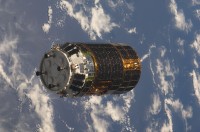The Japanese supply spacecraft HTV2, the European spacecraft Johannes Kepler and the Russian spacecraft Progress 42 will unload their cargo at the station and provide the astronauts with oxygen, food, fuel, scientific equipment, experiments and more

Three supply spacecraft will dock in the coming weeks to the space station, with about 10 tons of food, computers, medical equipment, supplies and spare parts.
The first spacecraft to be launched from Japan joins a long line of supply spacecraft from Japan, Europe and of course Russia. Kounotori2 or "Hasida 2" (abbreviated HTV2) was developed by the Japanese Space Agency (JAXA) and will be launched on a Russian Progress rocket from the Baikonur Space Center in Kazakhstan on January 28. The diameter of the Japanese spacecraft is 10 x 4 meters and it is capable of carrying internal and external supplies to the station. It will be launched from the Tangashima Space Center on an H-IIB model launcher with equipment weighing about 3.8 tons. The spacecraft will be docked in the American Harmonic Component on the station and then ejected to burn up in the atmosphere.
Only a week after the launch of HTV2, the European Space Agency will launch the 41st Progress model supply spacecraft. Progress 41 is planned for launch from Baikonur, with the same launch pad and launch team responsible for all Russian launches to the station - manned and unmanned. This spaceship will be docked at Pierce Dock carrying about 2.7 tons of fuel, food, water, air, equipment, research samples and more. At the end of April, the spacecraft will aim to burn up in the atmosphere and three days later will arrive at the same dock as the Progress 42 spacecraft.
Another European ATV series spacecraft named after Johannes Kepler is scheduled to launch from French Guiana on February 15 carrying 20 tons of equipment. This is a relatively large spacecraft that should provide an answer to the supply of the space station after the completion of the shuttle project.

5 תגובות
Hezy phobia…
http://science.nasa.gov/science-news/science-at-nasa/2000/ast02nov_1/
In my opinion, the water from the feces is not recycled, and even the water that is recycled, is recycled with a certain return, there is no 100 percent return. It is cheaper and more economical to bring water from the earth than to set up an expensive and complicated system
and takes up space, trying to grab every molecule.
Tamm's question, shouldn't there be full recycling of the water at the station? Why do you need to bring water all the time? The only water that is supposed to leave is moisture that enters the supply spacecraft and the bodies of the astronauts who leave it (and are usually replaced by new ones)
I am starting from the assumption that in recent years several tons of water have accumulated at the station from all the supplies